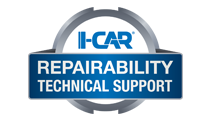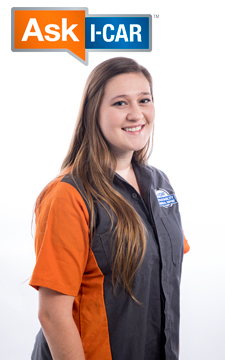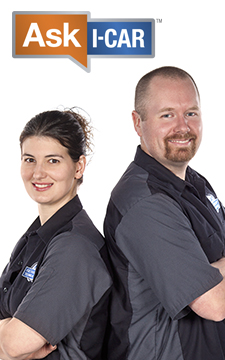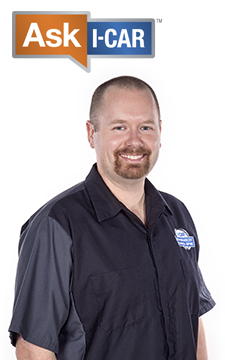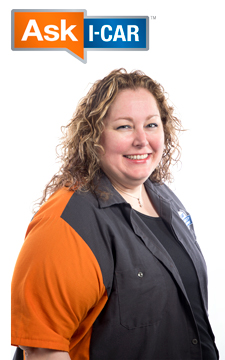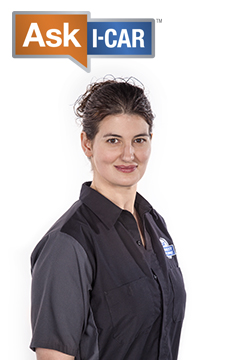GM Repair Insights: Summer 2025
Posted on 8 September 2025The summer edition of General Motors (GM) Repair Insights is now available.
High-Voltage Vehicle Research Tips: GM BEV Low-Voltage Battery Disconnection
Posted on 28 August 2025While researching OEM repair information, you may come across specific notes, instructions, or warnings for high-voltage (HV) vehicles. Some general procedures can be easily overlooked, so it’s important to identify these circumstances. Let’s see what unique considerations General Motors (GM) has on EVs during a low-voltage disconnect.
GM Part Replacement Without A Procedure
Posted on 22 August 2025We are often asked, “What do I do if there isn’t a procedure to replace a service part?” Let’s see what GM says.
Great Designs in Steel 2025 Presentations: A Closer Look At Body Structure Efficiency On D-Segment Crossover Architecture
Posted on 24 July 2025In case you missed it, Senior Body Engineer, Jinhui Wang presented Body Structure Efficiency On D-Segment Crossover Architecture at Great Designs in Steel 2025.
App-Based Connected Services Considerations: General Motors
Posted on 8 July 2025Have you had the experience where the vehicle notified the owner that it was being moved while it was in your repair facility? App-based connected services are available from many vehicle makers and may require special considerations before beginning repairs. Let's see what General Motors (GM) has to say.
Digital Key Considerations: General Motors
Posted on 8 July 2025The intermingling of technology and automobiles continues, with digital key offerings from most vehicle makers. Digital keys utilize smartphone technology to expand vehicle access and owner convenience. Let’s see what General Motors (GM) has to offer.
Weld-Through Primer Guidelines: General Motors - UPDATE
Posted on 2 May 2025Weld-through primers are generally a zinc-based product that are applied to the mating surfaces prior to welding. Corroding zinc forms zinc oxide which protects the steel. This is called sacrificial corrosion. For a quality weld to be made it’s required that the weld-through primer be removed from the direct weld zone before welding the joint when GMA welding. Many OEMs have a position on when and how to use weld-through primer or when it shouldn’t be utilized. Let’s see what General Motors (GM) recommends and where this information can be found.
GM Repair Insights: Spring 2025
Posted on 15 April 2025The spring edition of General Motors (GM) Repair Insights magazine is now available.
High-Voltage Handling And Storage Considerations: General Motors - UPDATE
Posted on 20 March 2025High-voltage (HV) vehicles have some special considerations for handling and storing HV batteries and other components. The dangers of HV batteries are potential even after removal which is why certain precautions are needed. Let’s see what General Motors (GM) has to say.
GM Repair Insights: Winter 2025
Posted on 10 March 2025The winter edition of General Motors (GM) Repair Insights magazine is now available.
GM Repair Insights: Fall 2024
Posted on 17 February 2025The fall edition of General Motors (GM) Repair Insights magazine is now available.
I-CAR Repairers Realm: Top 5 I-CAR RTS Linking Pins Of 2024 - Now Available
Posted on 2 January 2025I-CAR had a discussion on the top 5 I-CAR RTS linking pins of 2024.
I-CAR OEM Technical Information Matrix: What Is It, And How Does It Help? UPDATE
Posted on 5 December 2024Do you know which vehicle makers have collision repair information available? Do you know where you can go to find that out?
GM Repair Insights: Summer 2024
Posted on 20 September 2024The summer edition of General Motors (GM) Repair Insights magazine is now available.
I-CAR Repairers Realm: Vehicle Highlights From The Chicago Auto Show - Now Available
Posted on 3 July 2024I-CAR had a discussion on vehicle highlights from the 2024 Chicago Auto Show.
GM Repair Insights: Spring 2024
Posted on 13 May 2024The spring edition of General Motors (GM) Repair Insights magazine is now available.
GM Repair Insights: Summer 2023
Posted on 20 March 2024The summer edition of General Motors (GM) Repair Insights magazine has recently been made available.
GM Repair Insights: Fall 2023
Posted on 20 March 2024The fall edition of General Motors (GM) Repair Insights magazine has recently been made available.
GM Repair Insights: Winter 2024
Posted on 20 March 2024The winter edition of General Motors (GM) Repair Insights magazine is now available.
Repairer Driven News: GM First Responder EV Training
Posted on 28 February 2024Repairer Driven News (RDN) has released an article highlighting free online battery electric vehicle (BEV) first responder training from General Motors (GM).
OEM Linking Pin: GM Adhesively Bonded Joint Repair
Posted on 21 February 2024As part of the I-CAR Repairability Technical Support (RTS) OEM linking pin activity, we are helping to connect the collision repair industry to the vehicle makers. We‘ve had technical inquiries that asked for clarification on repairing parts or assemblies with adhesively bonded joints on GM vehicles.
General Motors High-Voltage Technician Levels: UPDATE
Posted on 5 December 2023As electric-only, hybrid, and fuel cell electric vehicles are increasing in sales, they are becoming more commonplace in repair facilities. Along with the unique powertrains that come with these vehicles, also comes unique safety concerns. Regardless of vehicle maker, high-voltage (HV) systems pose a threat of injury or death if not handled properly. Only personnel with the proper training, PPE, tools, equipment, and service information should perform work on the HV systems.
I-CAR Just In Time: GM Exhaust Shield Fasteners
Posted on 26 September 2023Sometimes seeing is understanding, that’s why I-CAR's technical team created the Just in Time video series to guide you through a variety of collision repair topics from ADAS and EVs to repair tips and tricks. These videos enable you to, in less than 5 minutes, learn something new. Let’s check out the tip the team has for General Motors (GM) exhaust shield fasteners.
Back-To-Basics: Door Handle Tools
Posted on 22 September 2023Sometimes, going back to the basics can make the difference between a quality repair and a failed repair. Tools for the door handle might not sound exciting, but they can save you frustration and possibly a refinish.
Locating ADAS Information: GM - UPDATE
Posted on 15 September 2023As a collision repair technician, there is one part of a service manual that houses all of the information you would ever need…right? This is not the case with modern vehicles. You may be required to look in numerous manuals to find the information required to safely repair the vehicle.
OEM-Approved Connector and Pigtail Repair Resources: General Motors
Posted on 6 July 2023When confronted with a wiring harness repair, we often struggle finding the correct connector and pigtail repair kits. Often a specific connector may be used on multiple applications. If the connector is allowed to be replaced, what resources are available to locate approved wiring connector and pigtail repair kits? Let’s see what is available from General Motors (GM).
Identifying The Correct Body Repair Manual: General Motors
Posted on 5 May 2023Vehicle makers may group their body repair manuals (BRM) in several different ways. Sometimes the BRMs are grouped by a year range, some are listed as VIN specific, and others are arranged by a body code. Let’s take a look at General Motors (GM) to see how they group their BRMs.
GM Repair Insights: Spring 2023
Posted on 28 March 2023The spring edition of General Motors (GM) Repair Insights magazine is now available.
GM Repair Insights: Summer 2022
Posted on 3 March 2023The summer edition of the General Motors (GM) Repair Insights magazine is now available.
GM Repair Insights: Winter 2023
Posted on 3 March 2023The winter edition of the General Motors (GM) Repair Insights magazine is now available.
Calibration Research Tips: 2017-2023 Buick Encore Blind Spot False Alerts
Posted on 26 August 2022While searching for information on advanced driver assistance systems (ADAS) on an OEM repair information site, you may come across unique calibration procedures, events, or bulletins. These events can vary by year and model, even within a particular make. As the RTS team has been researching these systems, we have been identifying these atypical circumstances. In order to help you better understand them, we are putting together a series of articles that help with the repair and calibration of ADAS. Let’s take a closer look at General Motors 2017-2023 Buick Encore.
GM Repair Insights: Spring 2022
Posted on 8 June 2022A spring edition of the General Motors (GM) Repair Insights magazine is now available.
One-Time-Use Parts And Fasteners: General Motors
Posted on 1 April 2022What is a one-time-use part, and how do you determine if a fastener, clip, or part can be reused? These are questions that we are confronted with in the collision industry quite a lot. The other big question is "Where do I find this information?"
As the Repairability Technical Support (RTS) team researches OEMs for one-time-use fastener/part information, we are putting together a series of articles on how and where to locate this information for specific OEMs. Let's take a look at General Motors (GM).
Locating OEM-Approved HV Tools: General Motors
Posted on 24 March 2022When researching procedures for disabling a high-voltage (HV) vehicle, you may notice that many of the procedures require the use of specific tools. Some of them are OEM-specific tools or scan tools. Often identifying and locating where to purchase these specific tools can be difficult.
The RTS team is researching how to find these tools to make it easier for technicians performing these tasks. As we research the location of these special tools, we are compiling the information in a series of OEM-specific articles.
GM Repair Insights: Winter 2022
Posted on 14 January 2022A winter edition of the General Motors (GM) Repair Insights magazine is now available.
GM Repair Insights: Fall 2021
Posted on 29 October 2021A fall edition of the General Motors (GM) Repair Insights magazine is now available.
GM ADAS Information Document: UPDATE
Posted on 20 October 2021General Motors (GM) has a document that covers advanced driver assistance systems (ADAS) information. The document provides an overview of all ADAS and components in one convenient location.
Repairer Driven News: General Motors Ultra Cruise
Posted on 13 October 2021Repairer Driven News (RDN) released an article highlighting an upcoming advanced driver assistance systems (ADAS) change for General Motors (GM).
GM Repair Insights: Summer 2021
Posted on 3 September 2021A summer edition of the General Motors (GM) Repair Insights magazine is now available. The issue highlights the 2022 Chevrolet Bolt EUV.
Rivet Guns: Does My Shop Need Them?
Posted on 23 July 2021When performing collision repairs, there are more attachment methods available than ever before. OEMs specify which attachment methods are recommended or required. If a method is not listed as an option, it should not be used.
OEM Emergency Response Guides: General Motors
Posted on 1 July 2021Are you looking for OEM emergency response guides (ERGs)? The Repairability Technical Support (RTS) team has located these guides and either houses them on the RTS website, provides links to webpages that house them, or provides articles with instructions on how to locate them.
Repairer Driven News: GM Updates Repair And Inspection Document
Posted on 11 June 2021Repairer Driven News (RDN) released an article on General Motors (GM) post-crash inspections and repair requirements document.
Locating OEM-Approved ADAS Tools: General Motors
Posted on 2 June 2021When researching calibration procedures for advanced driver assistance systems (ADAS), you may notice that many of the procedures require the use of specific tools. Some tools may be everyday items like string, tape, levels, paper, etc. However, many of them are OEM-specific tools or scan tools. Often identifying and locating where to purchase these specific tools can be difficult.
GM Repair Insights: Spring 2021
Posted on 19 April 2021A spring edition of the General Motors (GM) Repair Insights magazine is now available. This issue highlights the all-new 2021 Buick Envision’s technology, performance, and safety.
OEM Emergency Response Guides
Posted on 25 February 2021Are you looking for OEM emergency response guides (ERGs)? The Repairability Technical Support (RTS) team has located these guides and either houses them on the RTS website, provides links to webpages that house them, or provides articles with instructions on how to locate them.
Steel Spot And Plug Weld Nugget Size: GM - UPDATE
Posted on 12 February 2021Did you know that some OEMs specify nugget size for spot and plug welds? This information is typically found within vehicle-specific repair procedures or can be found under general welding guidelines. Let’s see what General Motors (GM) has to say.
GM Repair Insights: Winter 2021
Posted on 13 January 2021A winter edition of the General Motors (GM) Repair Insights magazine is now available.
General Motors: Who Requires Or Recommends MIG Brazing?
Posted on 30 December 2020In Europe, MIG brazing has been required or recommended on a widespread basis for several years. In the U.S., MIG brazing is not as common but is becoming more prevalent. As the RTS team is researching MIG brazing information, we are putting together a series of articles that identify OEM-specific MIG brazing recommendations and requirements for vehicles in the U.S. Let’s see what General Motors (GM) has to say.
Who Requires Or Recommends MIG Brazing? UPDATE
Posted on 25 November 2020In Europe, MIG brazing has been required or recommended on a widespread basis for several years. In the U.S., MIG brazing is not as common but is becoming more prevalent. As the RTS team is researching MIG brazing information, we are putting together a series of articles that identify OEM-specific MIG brazing recommendations and requirements for vehicles in the U.S.
I-CAR Collision Repair Of The 2021 General Motors (GM) Full-Frame Sport Utility Vehicles (SUV) Course
Posted on 16 October 2020The GM full-frame SUVs have undergone a redesign for 2021. This has brought about various structural changes, as well as construction material changes.
GM Repair Insights: Fall 2020
Posted on 14 October 2020A fall edition of the General Motors (GM) Repair Insights magazine is now available.
Hybrid And Electric Vehicle Article Hotspot
Posted on 17 September 2020Since hybrid and electric vehicles first started becoming relevant, members of the collision repair industry have required as much knowledge as possible on these subjects. I-CAR’s Repairability Technical Support (RTS) team continues to be on the leading edge of research and education. Our goal is to help communicate information to the industry, and a great way to do this is through Collision Repair News articles.
GM Repair Insights: Summer 2020
Posted on 22 July 2020A summer edition of the General Motors (GM) Repair Insights magazine is now available.
Refinishing Park Assist Sensors: GM
Posted on 21 July 2020Park assist sensors are part of the park assist system, just one of many advanced driver assistance systems (ADAS) found on vehicles today. Damaged sensors are typically replaced and may require painting to match the vehicle. Vehicle makers often provide information on the painting of new sensors. Some vehicle makers do not recommend refinishing sensors with minor finish damage because excessive paint thickness may adversely affect the operation of the park assist system. However, other vehicle makers allow refinishing and provide guidelines. Let’s see what General Motors (GM) has to say.
OEM ADAS Information Documents
Posted on 1 July 2020As advanced driver assistance systems (ADAS) are now commonplace and becoming available on even entry level models. Having information on ADAS, and when calibration is required for these systems is more important than ever.
GM Has Video Procedures
Posted on 24 June 2020Looking for more information about a specific repair procedure? Some OEMs are now providing videos within the repair procedures on their service site. Vehicle makers may also have additional websites that contain repair videos. As we research OEM websites and find these helpful videos, we will write articles to let you know. Let’s take a closer look at General Motors (GM).
Straightening And Heat: General Motors
Posted on 20 May 2020A question often asked of the Repairability Technical Supports (RTS) team is, "Can heat be used to straighten?" Several OEMs provide steel repairability matrices that provide heating times and temperature limits based on the type of metal being repaired, while other OEMs have restrictions on using heat at all. Let’s see what General Motors (GM) has to say.
GM Repair Insights: Spring 2020
Posted on 19 May 2020A spring edition of the General Motors (GM) Repair Insights magazine is now available.
Where Do I Find Other Types Of Information In General Motors?
Posted on 19 March 2020Navigating OEM websites can be challenging when searching for collision repair procedures, especially as no two OEM websites are alike. What happens when you need to find other types of repair information, such as, "What needs to be inspected after a supplemental restraints system (SRS) deployment?", or "Does the tire pressure monitoring system (TPMS) require a scan tool or specialty tool?" Let's take a closer look at the General Motors (GM) website.
Calibration Research Tips: GM Manuals That Share A Common Platform
Posted on 4 March 2020While searching for information on advanced driver assistance systems (ADAS) on an OEM repair information site, you may come across unique calibration procedures or events. These events can vary by year and model, even within a particular make. As the RTS team has been researching these systems, we have been identifying these atypical circumstances. In order to help you better understand them, we are putting together a series of articles that help with the repair and calibration of ADAS. Let’s take a look at GM manuals that cover multiple vehicles.
GM Repair Insights Website
Posted on 6 February 2020The GM Repair Insights website is back up after being down for a number of months. The Repairer News section of the site has solutions to specific issues for GM vehicles, such as wind noise on full-size trucks. With the re-publishing of this website, comes two new issues of the Insights magazine.
General Motors: Overlap Joint Procedure In Body Repair Manual
Posted on 15 October 2019Many General Motors repair procedures call for an overlap joint when replacing certain panels. There is now a separate “Overlap/Backing Plate Sectioning” procedure in some of the body repair manuals (BRM) on how to carry out the overlap joint.
Sectioning and Partial Part Replacement: 2019 Buick Regal
Posted on 3 June 2019One of the top technical inquiries received at Ask I-CAR is “Is there a sectioning or partial replacement procedure available?” To help answer this question, RTS has an OEM Partial Part Replacement Search available. Here you will find information on if these procedures are available on a specific vehicle. Let’s take a closer look at the 2019 Buick Regal.
General Motors Free Body Repair Manuals No Longer Available
Posted on 22 May 2019As you may know, General Motors has removed the body repair manuals from their free website www.gmparts.com.
Bumper Cover Repair With ADAS: General Motors
Posted on 7 May 2019A simple bumper repair on a modern vehicle may not be as simple as it seems. New technologies like blind spot monitoring, adaptive cruise control, and other advanced driver assistance systems (ADAS) utilize sensors behind the bumper covers. The ability for these sensors to be able to see clearly normally requires special caution when considering a bumper repair. Many OEMs have different levels of warnings when it comes to repairing bumper covers with ADAS. So, what does General Motors (GM) say on the subject?
General Motors: Spot-Weld Replacement
Posted on 16 April 2019There is sometimes confusion on how many spot welds to use when replacing body components. Sometimes you replace what you removed, sometimes you use more or less than what was removed. It all depends on the particular vehicle you are repairing and what the manufacturer requires to be done. Luckily General Motors (GM) has a good way of identifying how many welds to use to install the new part.
Backup Batteries and Main Battery Disconnect
Posted on 9 April 2019Backup batteries sometimes referred to as auxiliary or supplemental batteries, serve an important role in maintaining power for certain vehicle systems even while the 12-volt battery power is cut. The backup batteries can aid in emergency situations by maintaining power for features like GM OnStar, Toyota Safety Connect System, and FCA Assist to name a few.
GM Navigation Video: UPDATE
Posted on 22 March 2019General Motors (GM) has updated their www.acdelcotds.com service and repair information website. This update to the website changes how to find the collision repair information you need.
General Motors Goes Beyond Written Procedures
Posted on 5 March 2019We’ve shared that OEMs like FCA, Honda/Acura, and Kia have videos within their procedures. Now, General Motors (GM) has added videos to various procedures in service manuals at www.acdelcotds.com.
OEM Linking Pin: 2018 Buick Regal MIG Brazing
Posted on 27 February 2019As part of the I-CAR Repairability Technical Support (RTS) OEM linking pin activity, we are helping to connect the collision repair industry to the vehicle makers. The roof of the Buick Regal is laser brazed from the factory along both sides of the roof. In repairs, Buick repair procedures require MIG brazing to replace the laser brazed seam, a first from GM. Recently we had a technical inquiry that asked if adhesive bonding, instead of MIG brazing along both sides of the roof, could be used to replace the roof.
OEM Linking Pin: Buick LaCrosse Outer Quarter Panel Sectioning
Posted on 22 February 2019As part of the I-CAR Repairability Technical Support (RTS) OEM linking pin activity, we are helping to connect the collision repair industry to the vehicle makers. Recently we had a technical inquiry that asked, about a procedure on a Buick Lacrosse.
ADAS, Calibration, And Scanning Article Hotspot
Posted on 14 January 2019Since advanced driver assistance systems (ADAS), scanning, and calibration first started becoming relevant, members of the collision repair industry have required as much knowledge as possible on these subjects. I-CAR’s Repairability Technical Support (RTS) team continues to be on the leading edge of research and education. Our goal is to help communicate information to the industry, and a great way to do this is through Collision Repair News articles.
Non-SRS Wiring Repairs: General Motors
Posted on 28 September 2018What is a non-SRS wiring repair? It is the repairing of an electrical component that is not part of the supplemental restraints system circuit (usually identified by yellow wire looms). As technology increases on vehicles, so does the number of components that utilize electricity. Many of the sensors and modules are becoming smarter and more sensitive. If the wire is too long, the wrong gauge, or spliced in the wrong location it can cause malfunctions in the components that it’s powering. Many OEMs have different restrictions and guidelines for repairing wiring that does not control SRS components. On the other hand, there are OEMs that don’t allow wiring repairs at all, so full harness replacement is the only option.
GM: Applying Impact Resistant Structural Adhesives
Posted on 12 September 2018According to gmrepairinsights.com, there are rules that must be followed when using impact resistant (I.R.) structural adhesives. Per Bob Hiser, GM Lead Service Engineer, “The glue doesn’t tell you what it is or how to fix it.” This means that being trained and following the OEM repair instructions are crucial to a proper repair.
General Motors Now Accepting Collision Repair Network Applicants
Posted on 9 August 2018General Motors (GM) has launched their new Collision Repair Network and it is now open for enrollment. There are a number of qualifications an interested shop will be required to meet, including I-CAR training.
Sectioning and Partial Part Replacement: 2017 Buick Enclave
Posted on 21 February 2018One of the top technical inquiries received at Ask I-CAR, “Is there a sectioning or partial replacement procedure available?” To help answer this question, RTS has an OEM Partial Part Replacement Search available. Here you will find information on if these procedures are available on a specific vehicle. Let’s take a closer look at the 2017 Buick Enclave.
Metal Panel Bonding on General Motor’s Vehicles
Posted on 5 December 2017General Motors (GM) has updated their Metal Panel Bonding technical document on their gmparts website. Let’s take a look at this document.
Tackling the Repair of Mixed-Material Vehicles
Posted on 11 September 2017ABRN published an article titled, Tackling the Repair of Mixed-Material Vehicles. Let’s take a look at this article.
Repairer Driven News: GM Squeeze-Type Resistance Spot Welding Expands for 2018 Models
Posted on 22 August 2017What’s on the repair agenda for 2018 GM vehicles? The expanded use of squeeze-type resistance spot welding (STRSW) over plug welds in the collision repair process. Repairer Driven News (RDN) published an article highlighting this upcoming change.
Body Construction And Material Repair Guidelines: General Motors
Posted on 19 July 2017What is the MPa of the front lower rail? What is the outer uniside made of: steel, aluminum, or composite? Can heat be used to straighten or is it cold straightening only? What are the repair limitations? These are just some of the questions that the RTS team fields on a daily basis.
Corrosion Protection Guidelines: General Motors
Posted on 23 June 2017A key factor in collision repair is making long-lasting repairs. When a vehicle is repaired, many areas of corrosion protection are disturbed. This creates corrosion hot spots that left untreated will lead to corrosion and potentially a repair failure. However, there are certain precautions that can be taken to safely and properly restore the corrosion protection throughout the repair process. OEMs often give specifications on restoring corrosion protection. These specifications generally include seam sealer, adhesives, foam fillers, and cavity waxes. Let’s take a look at what General Motors (GM) says.
New Calibration Requirement From General Motors
Posted on 18 May 2017There is new information available when it comes to windshield replacement on General Motors (GM) vehicles. In the past, forward facing camera calibration was not required when replacing the windshield. Let’s take a look at the new requirement from GM.
Additional Calibration Requirements: General Motors
Posted on 5 May 2017The addition of the OEM Calibration Requirements Search to the RTS portal was a big step for the collision industry. While this new feature has been well received, there has been some confusion about what is included in the search tool. The OEM Calibration Requirements Search is designed to provide information on the calibration requirements that are needed for vehicles equipped with advanced driver assistance systems (ADAS). This includes systems such as adaptive cruise control, lane keep assist, and collision braking.
Collision Hub - Repair University Live: OEM Repair Procedures Featuring General Motors and I-CAR
Posted on 4 April 2017Collision Hub is a well-known source for collision repair news and information. On the Collision Hub website, you can find a monthly news report (Collision Hub Network News - CHNN), a blog, Repair University, and a relatively new feature Repair University Live. To view Repair University Live, you will need to purchase a subscription. However, the next episode, coming up on April 12, at 12:00 PM Eastern, will be sponsored by BASF, so it will be free to the public. Let’s take a look at how to view this episode and what it will include.
Structural Sectioning Procedures: General Motors
Posted on 22 March 2017Ask I-CAR receives many technical inquiries referring to sectioning. The collision repair industry wants to know where can you section, does the OEM have a sectioning procedure, and where can I find the sectioning procedure? Most OEMs allow sectioning to outer body panels and the front and rear rails. Sectioning reinforcements is not as common, as most reinforcements are replaced at factory seams.
GM Glass Replacement Requirements
Posted on 10 November 2016The role of the windshield is a lot more complex than simply allowing a view of the road ahead. It is considered a structural part of the vehicle as it contributes to the strength of the roof and A-pillars. The windshield helps to manage collision energy and has become an integral part of several advanced safety systems.
General Motors Position Statement: Pre- and Post-Repair System Scanning
Posted on 21 October 2016As the industry continues to ask, are pre- and post-repair scans necessary, General Motors provides their answer.
Collision Information Website Access: General Motors
Posted on 17 October 2016Why do I need a subscription to an OEM website if I have full subscription access to the I-CAR Repairability Technical Support (RTS) portal? This is a question received on a regular basis through Ask I-CAR. Let’s take a look at why and how to purchase an OEM subscription.
General Motors Updates Position Statements
Posted on 23 August 2016General Motors has followed suit with other OEMs by updating their position statement to disallow the use of recycled and salvage parts.
Always Follow Vehicle Maker Procedures
Posted on 7 July 2016We often receive Ask I-CAR inquiries asking: “what does I-CAR recommend?” Many times these questions are in regards to sectioning, straightening, or part replacement/attachment methods. Our first response is always:
Future OEM Joining Technologies
Posted on 27 May 2016As OEMs continue to evolve the joining technologies used for new steel, aluminum, carbon fiber, and mixed material vehicles, I-CAR often gets questions of “what does this mean for the collision repair industry?”
Restraints Wiring Repairs
Posted on 23 May 2016Over the past few months, we've been sharing OEM position statements on restraints wiring repairs. Now we're bringing them all together in one place for easy reference.
General Motors Restraints Wiring
Posted on 22 March 2016The question is often asked, "Can supplemental restraints system wiring be repaired?" The answer is: it depends on the vehicle maker. Let's take a look at General Motors' (GM) position on this subject.
Making Automatic Emergency Braking (AEB) A Standard Feature
Posted on 24 September 2015A group of vehicle makers got together recently and discussed the future of automatic emergency braking (AEB) technology in their vehicles. This feature is designed to reduce the severity and frequency of collisions; but no matter how good it is, it will never prevent all accidents from happening. So what do you need to know in order to repair vehicles with AEB, and how do you know the system is functioning properly?
Paint Friendly Service Parts Coming From GM: UPDATE
Posted on 14 August 2015As a follow-up to the previous article on Paint Friendly Service Parts Coming From GM, General Motors has already begun supplying the part kits for some of their paint-to-match assemblies. The parts initially include door mirrors, headlamps, and door handles for some vehicles in 2015. For the 2016 model year, they will become available for most models, and for more than just these parts.
OEM Hybrid And Electric Vehicle Disable Update: General Motors
Posted on 14 July 2015The I-CAR developed OEM Hybrid And Electric Vehicle Disable Search has been updated to include all General Motors makes including Buick, Cadilla, Chevrolet, and GMC hybrid vehicles through the 2024 model year.
Step-By-Step: Accessing General Motors Repair Information
Posted on 13 March 2015Per your requests, we are adding step-by-step instructions on how to access the vehicle maker repair information to complement our how-to-videos on the OEM Information pages. Easily reference this article by clicking the link under the video on the Chevrolet OEM Information, Buick OEM Informationpage, GMC OEM Informationpage, and Cadillac OEM Information page.
Bumper Energy Absorbers, Crush Boxes, and Bumper Reinforcements
Posted on 28 February 2015Let's go back to basics with the ever-popular what to do with bumper energy absorbers, crush boxes, and bumper reinforcements.
Recommended General Motors Steel Repairability Matrix
Posted on 9 February 2015The Recommended GM Steel Repairability Matrix is a chart that identifies GM’s repair recommendations according to the type of steel that the part is made from. The matrix contains information on the steel identification stamping symbols, steel grade, GM specifications, recommended welding methods, cold repairability, use of heat for repairs, the temperature range that should be used, and the maximum heat allotment. The second page of the matrix is a chart of Descriptions of GM Steel.
Restraints System Wiring Repairs
Posted on 6 February 2015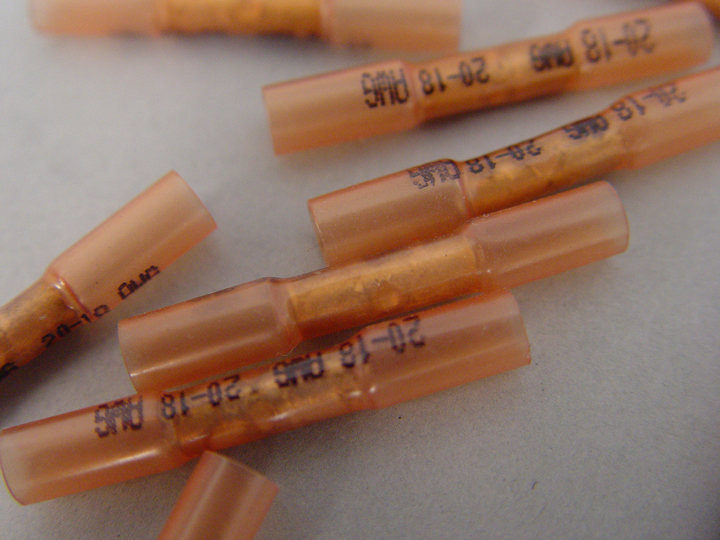 Figure 1 - These crimp and seal splice sleeves have special heat shrink sleeves on each end that shrink around the wire and form an air-tight seal.Confusion exists within the collision industry concerning the repair of some damaged wiring and wiring connectors for restraints systems. The perception is that restraints system wiring should never be repaired. While it is true that some vehicle makers do not recommend the repair of wiring and connectors for the restraints system, others have very detailed printed procedures and even offer repair kits expressly for the repair of restraints system wiring. Repairing damaged restraints system wiring, when applicable and the parts and procedures are available, can save unnecessary replacement of the main body and instrument panel wiring harnesses.
Figure 1 - These crimp and seal splice sleeves have special heat shrink sleeves on each end that shrink around the wire and form an air-tight seal.Confusion exists within the collision industry concerning the repair of some damaged wiring and wiring connectors for restraints systems. The perception is that restraints system wiring should never be repaired. While it is true that some vehicle makers do not recommend the repair of wiring and connectors for the restraints system, others have very detailed printed procedures and even offer repair kits expressly for the repair of restraints system wiring. Repairing damaged restraints system wiring, when applicable and the parts and procedures are available, can save unnecessary replacement of the main body and instrument panel wiring harnesses.
What's A GM Center Pillar?
Posted on 22 December 2014When it comes to repair information, vehicle makers use a wide variety of terminology for replacement parts. All of the different names can be confusing, especially when repairing a variety of vehicle makes and models. Thankfully, General Motors (GM) uses terms that most of us are familiar with.
Today’s Advanced Vehicles Require Changes in Collision Repair Attachment Methods - Part 1
Posted on 20 December 2014This article originally appeared in the November/December edition of Fixed Ops Magazine.
Collision repair professionals are no different than any other professional – we are resistant to change. It took many years for repairers to make the switch to “MIG welding” for welding early unibody vehicles. (For this article we’ll use the term gas metal arc welding (GMAW) metal inert gas (MIG), or GMA (MIG)). (More on the reason, later.) It was a technology that was unfamiliar to many and there wasn’t a perceived need for change. History would prove otherwise, as there may not be a collision repair business in the country that doesn’t have a GMA (MIG) welder.
Repair or Replace? – Material Tensile Strength Key to Repairability
Posted on 23 September 2014Repair or Replace? – Material Tensile Strength Key to Repairability
Jason Bartanen, I-CAR Director, Industry Technical Relations
The world of steels continues to evolve at a rapid pace and repair professionals need to keep up. In order to perform complete, safe, and quality repairs, it’s imperative to identify the type of material we’re working with, to know what is repairable, and know which options we have for part replacement when straightening is not an option.
Strategy Based Diagnostics In Collision Repair
Posted on 19 September 2014by Chuck Olsen, Collision Diagnostic Services (CDS)
Strategy Based Diagnostics is an automotive best practice routine that was initially published by GM after studying and observing successful technicians in the field who consistently meet or exceed productivity standards with the lowest levels of "re-checks" or "comebacks." Since GM published this best practice, Strategy Based Diagnostics has been adopted by most in the automotive repair field.
Weld-Through Primer Requirements On The OEM Technical Information Matrix
Posted on 28 August 2014Let's continue our breakdown of the columns in the OEM Technical Information Matrix. The eighth column calls out if the vehicle maker requires the use of weld-through primer on flanges in preparation for welding.
Collision Repair Attachment Methods, Description, And Equipment Requirements Information On The OEM Technical Information Matrix
Posted on 13 August 2014Let's continue our breakdown of the columns in the OEM Technical Information Matrix. The seventh column calls out if the vehicle maker has information in regard to the recommended attachment method and the equipment required for complete, quality, and safe repairs.
It's Not Just About Aluminum
Posted on 30 July 2014Today's Vehicles Require Updated Collision Repair Tools And Training
by Jason Bartanen
Ever since the unveiling of the 2015 Ford F-150 at the North American International Auto Show in Detroit in January, the U.S. automotive industry has been buzzing about this game changing, aluminum intensive vehicle.
Is There a Procedure for Disassembling a Service Assembly?
Posted on 19 June 2014The fourth column in the OEM Technical Information Matrix: Partial Service Part/Assembly Replacement Procedures at Factory Seams, can get a little tricky without further clarification. For the most part, this is a column that I-CAR is still researching published OEM information to get the answers to. The question is: Does the vehicle maker have procedures for replacing a partial service part or assembly at factory seams?
Can You Section A General Motors Vehicle Without A Procedure?
Posted on 28 March 2014Did you know that in 2013, General Motors published a position statement that identifies that sectioning should only be performed in recommended areas? This warning is applicable to all GM lines including Buick, Cadillac, Chevrolet, and GMC.
General Motors eAssist Electric System
Posted on 11 October 2012Another version of electric-assist vehicle technology is showing up in collision repair facilities. General Motors in 2012 introduced what it refers to as "light electrification" technology on select models. This system is called eAssist, and is available on some 2012 Buick LaCrosse, Regal, and 2013 Chevrolet Malibu models (see Figure 1).
General Motors Overlap Sectioning Joint
Posted on 31 May 2012Until recently, General Motors has generally specified butt joints with backings when sectioning parts of a uniside. However, an overlap joint is now being required for some uniside sectioning joints. This is being done to reduce the transfer of heat from GMA welding into heat-sensitive high- and ultra-high-strength steel reinforcements. The concern with a butt joint with backing is that the backing piece does not extend to the pinchweld flange, and leaves the reinforcement exposed. As a result, a GMA weld is made on the pinchweld flange area of the reinforcement (see Figure 1).
Three-Dimensional Measuring Equipment - Is It Really Necessary?
Posted on 8 September 2011I-CAR has been emphasizing the importance of three-dimensional measuring since its founding in 1979, but is it really required to repair a vehicle? After all, three-dimensional measuring systems are considerably more expensive compared to the much more affordable tape measure or tram gauge (see Figure 1).
